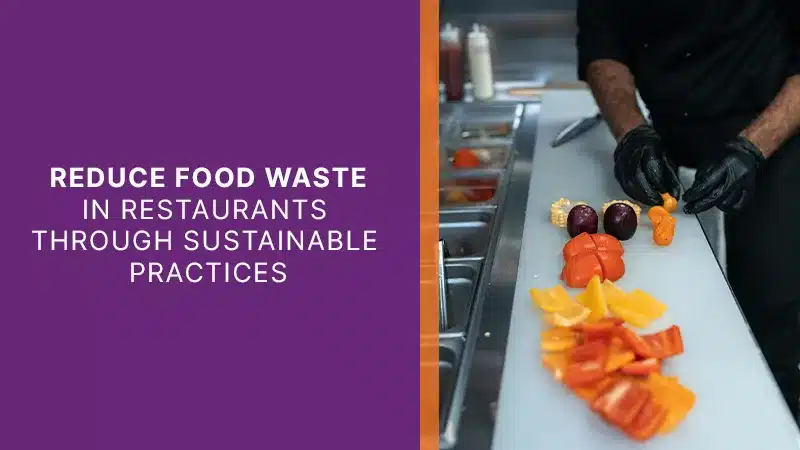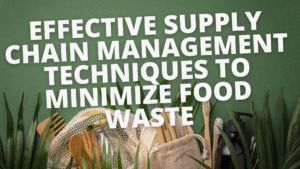Every year, restaurants worldwide throw away tons of food, contributing to an alarming global issue known as food waste.
How big is the issue? Well, according to the United States Department of Agriculture, as much as 40% of the food supply ends up wasted.
The sheer volume of discarded food is not just a logistical problem; it highlights inefficiencies and missed opportunities within the food service industry. Sustainable practices can be the key to transforming this waste crisis into an environment-friendly solution.
There are a number of ways of combating food waste that you can start doing today! From conducting food waste audits to menu engineering and even involving customers in the process, we will cover these actionable steps to foster a more sustainable and waste-conscious dining experience.
Working to Reduce Food Waste: Why Bother?
Short answer: it saves you money and makes your restaurant more sustainable.
Implementing accurate portion control and efficient inventory management can significantly reduce food waste.
Employee engagement ensures everyone, from chefs to waitstaff, understands the importance of reducing food scraps and leftover food. Training on customer preferences and managing surplus food can further enhance these efforts.
Additionally, offering adaptable portion sizes allows customers to make informed choices, reducing waste and increasing menu affordability. By working together, the restaurant industry can address food insecurity and optimize its food supply, ensuring surplus food reaches food banks or those who are food insecure.
Different Types of Food Waste
Generally speaking, there are two types of waste: pre-consumer waste and post-consumer waste.
Pre-Consumer Waste
Pre-consumer waste occurs before food reaches the customer.
Additionally, about a fifth of municipal solid waste in the U.S. comprises food waste, which stems from poor inventory management and inadequate storage practices. Below, we’ll get into several methods you can use to tackle this issue.
Post-Consumer Waste
Post-consumer waste is when food is discarded after reaching the customer.
In 2023, approximately 12.7 million tons of surplus food from the restaurant and food service industry were sent to landfills, underlining the significance of post-consumer waste.
Unfinished meals and returned dishes are primary contributors, making portion control and strategic menu planning critical. Addressing consumer education and behavior is essential for reducing this type of waste.
Reducing pre-consumer and post-consumer waste in restaurants is vital for improving sustainability and minimizing the ecological footprint of the food service industry.
How to Track and Reduce Restaurant Food Waste
Reducing food waste in the restaurant industry is crucial for better profitability, environmental responsibility, and addressing food insecurity.
By implementing systematic tracking and reduction strategies, restaurants can mitigate excess food disposal, minimize environmental impacts, and enhance operational efficiency. Here’s a comprehensive guide on how to address food waste in a restaurant setting.
Conduct a Food Waste Audit
Conducting a food waste audit is foundational in understanding the scope of food loss and waste within your establishment.
This process involves segregating discarded food into designated bins to identify categories like produce, meat, and post-consumer waste. Implement a food logging system to track these categories and pinpoint frequently wasted items.
Audits provide valuable insights, enabling restaurants to adjust recipes, inventory management, and menu planning based on waste patterns. This targeted approach not only reduces waste but also improves profitability.
Digging through the trash is not fun, but tracking what you’re throwing out is an important first step in good food waste reduction practices. Think of it as indirect customer feedback. If food is being thrown away, then perhaps portion sizes are too large, or diners aren’t enjoying it. Sorting through food waste and capturing the data it generates can pay huge dividends in the long run.
The Place to Start Reducing Waste is in Your Kitchen
The journey to reduce food waste begins in the kitchen.
Implement effective inventory management techniques, such as portion control and staff training on food storage.
Adopting smart scales and predictive analytics can optimize just-in-time cooking, which helps in preparing only what is needed, thereby decreasing overproduction.
Encourage kitchen staff to repurpose vegetable scraps for stocks and use trimming wisely to minimize waste. Automated kitchen systems can further reduce human error and food preparation inefficiencies.
Inventory Control is King
Accurate inventory management is pivotal in mitigating food spoilage and preventing over-purchasing.
Accurately ordering and employing stock rotation practices, like First In, First Out (FIFO), ensures that older stock is used first, reducing the risk of spoilage. Using inventory management software integrated with POS systems enhances the efficiency of tracking stock levels and placing accurate orders based on demand.
Regular assessment of inventory levels allows for better demand forecasting, thus minimizing waste and optimizing costs.
Make Sure all Food is Properly Stored
Proper food storage practices play a significant role in waste reduction.
Create shelf-life charts and label products immediately after delivery to optimize food storage and prevent spoilage. Implementing perishable item usage and regular skimming of used cooking oil can extend their usability and improve waste management.
Training staff in proper food handling and storage techniques is essential to the success of these initiatives, ensuring that food waste reduction efforts are sustained.
Keep your food storage facilities clean and functioning correctly, especially cold storage facilities that store perishable food! A broken freezer can result in considerable losses in spoiled food.
Establish Days on Hand (DOH) for all of Your Ingredients
Calculating Days on Hand (DOH) for ingredients helps prevent over-purchasing and spoilage.
Simply put, DOH is the number of days an ingredient sits in storage before it’s used. Figuring out DOH for your ingredients can help you fine-tune your purchasing and minimize the amount of ingredients you have on hand, saving money and space and reducing the potential for waste.
Robust POS data capture and inventory management systems (like ours) can help you figure this out.
Repurpose Ingredients to Reduce Food Waste
Repurposing is an innovative approach to minimizing food waste.
For instance, while being vigilant about food safety, you might train staff to use vegetable scraps for stocks and compost food waste where possible.
Partnering with upcycling companies can transform kitchen byproducts into new ingredients, offering opportunities for sustainability storytelling and menu integration.
Encouraging in-house repurposing practices ensures surplus food is used effectively, reinforcing the commitment to reducing waste.
Menu Engineering
Engage in menu engineering to minimize food waste.
Design menus that feature dishes with overlapping ingredients to maximize ingredient usage. Regular assessments of menu items can identify and remove those that do not sell well, preventing unnecessary storage of ingredients. Clear dish descriptions reduce the likelihood of returns and subsequent waste.
Employing dynamic pricing for end-of-day items encourages sales of surplus food, supporting more efficient inventory utilization.
Consider Composting to Reduce Food Waste
Composting offers a sustainable solution to managing food scraps.
It involves converting organic matter into nutrient-rich fertilizer for gardening or restaurant use. Restaurants can invest in commercial composters or partner with industrial composting companies to manage food waste responsibly.
Suitable compostable materials include food scraps, coffee grounds, and eggshells, but avoid cooked food, meat, dairy, and oils. Sending excess food to composting facilities reduces waste sent to landfills and promotes environmental sustainability.
Get Your Customers Involved
Engage your customers in waste reduction efforts by highlighting dishes made with upcycled or imperfect produce.
Offer discounts for customers who finish their meals, opt for smaller portions, or bring reusable containers instead of using disposable takeout containers, incentivizing responsible dining. Provide eco-friendly takeout options to encourage leftover management. Establishing dialogue about sustainability efforts can foster loyalty among eco-conscious customers. Well-labeled composting and recycling bins in dining areas also promote proper waste disposal.
By adopting these strategies, restaurants can significantly reduce food waste, enhance operational efficiency, and contribute positively to environmental sustainability and food security.
The Benefits to Your Restaurant from Reduced Food Waste
Reducing food waste in restaurants offers numerous benefits, both financially and environmentally.
By implementing effective inventory management, including the use of inventory management software and real-time temperature monitoring systems, restaurants can optimize stock levels, curtail over-purchasing, and prevent spoilage, thereby lowering costs.
Engaging kitchen staff in waste tracking fosters a sustainable culture, encouraging proactive participation and enhancing overall operations.
Menu design plays a vital role by promoting ingredient reusability across dishes and eliminating underperforming items, which helps minimize the chances of ingredients going unused and spoiling.
Portion control is another key strategy.
By offering adaptable portion sizes, restaurants can reduce customer leftovers, allowing diners to make informed choices and try more menu items at lower prices. This not only appeals to eco-conscious customers but also addresses environmental impacts such as food spoilage and greenhouse gas emissions like carbon dioxide.
Furthermore, reducing food waste helps combat food insecurity by facilitating the donation of surplus edible food to food banks. Check with your municipal or state government for details on how this works in your area.
There are customer satisfaction benefits as well. By focusing on food waste reduction strategies, restaurants can boost their image among eco-conscious diners while simultaneously contributing to a more sustainable food service industry.
Benefits of Reducing Food Waste
| Benefit | Description |
|---|---|
| Environmental Impact | Reduces carbon dioxide emissions and the environmental footprint of excess food production. |
| Cost Reduction | Lowers the cost of food waste management and minimizes food spoilage expenses. |
| Enhanced Public Image | Appeals to eco-conscious customers and improves brand reputation. |
Food Waste Reduction Requires Good Data
Reducing food waste in the restaurant industry is not just about throwing less excess food away. It requires a strategic approach backed by data.
One effective tool in this endeavor is utilizing inventory management systems like SynergySuite’s integrated restaurant management tool which utilizes AI and machine learning to capture and analyze crucial data to minimize waste.
How can our suite of applications help? Here are just a few ways:
- Inventory Management: Maintain optimal inventory levels and use perishable items efficiently to minimize food spoilage, by knowing when to order what, you are already two steps ahead of the game.
- Cost Savings: Better data means more accurate purchasing and reduced food supply costs.
- Employee Engagement: Data-driven insights engage kitchen staff in proactive practices to maximize the use of excess or extra food.
By leveraging data, restaurants can address food scraps and loss while considering food safety and environmental impacts.
The result is a streamlined operation that supports eco-conscious customers and tackles food insecurity issues. Implementing a robust system like this reduces the cost of food waste and reduces carbon dioxide emissions by minimizing spoiled food.
The average restaurant already has considerable operating costs. Let SynergySuite help keep them contained by reducing the amount of waste in your restaurant. We can help you generate accurate records and make data-driven decisions to reduce waste and maximize profit in all of your locations.
Get in touch with us today for a free, personalized demo!






